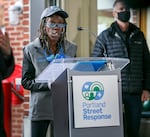
Portland police investigate the scene at a Motel 6 where earlier an officer shot and killed Michael Ray Townsend on June 24, 2021 in Portland, Oregon.
Jonathan Levinson / Jonathan Levinson
Editor’s note: This story talks about suicide. If you or someone you know is contemplating suicide, call for help now. The National Suicide Prevention Hotline is a free service answered by trained staff 24 hours per day, every day. The number is 1-800-273-8255. Or text 273TALK to 839863.
An ambulance brought Michael Ray Townsend to the Legacy Good Samaritan emergency department in the early evening on June 22, two days before he was shot and killed by a Portland police officer.
Treatment records from that visit reviewed by OPB show police had called the ambulance for him because he was expressing suicidal ideations and had abdominal pain. According to a nurse’s notes, Townsend said he was “kind of trippin.” He was given a sedative and put in a room by himself.
About six hours after he arrived, Townsend chewed through his IV and a nurse saw him try to stick a gum wrapper into an electrical outlet.
“He notes that ‘he’s just not into staying in the hospital again and would like to leave,’” a nurse wrote in their notes.
That nurse said Townsend was no longer paranoid, that methamphetamine in his system appeared to have cleared, and he no longer met the criteria for a psychiatric hold. Records say Townsend, who had been diagnosed with rhabdomyolysis, anemia and acute kidney injury, had the capacity to make decisions for himself. Medical staff explained the risks of leaving early, and Townsend was told he may return to the hospital at any time to resume care.
Townsend signed himself out of the ER. On June 24, he called 911 saying he was thinking about hurting himself again, and that he had the means to do so, later revealed to be a sharp tool used to repair flat tires. That call for help ended when Portland police officer Curtis Brown shot and killed Townsend in a North Portland Motel 6 parking lot.
“He did a lot of the right things,” a health care provider familiar with Townsend’s history told OPB. “He called the crisis line in the past and he went to the urgent walk-in clinic. He did what he was supposed to do when he was in a mental health crisis. If somebody who is actively advocating for their own care gets to this point, it doesn’t bode well for everybody else.”
The provider asked not to be identified because they aren’t authorized to speak to the media.
Townsend is one of at least two people shot this year by a Portland police officer while appearing to be in the midst of a mental health crisis. Medical records reviewed by OPB from multiple health care providers show both Townsend and Robert Delgado, who Portland police shot and killed in April, had sought mental health care several times in the days and months leading up to their deaths.
The shootings reinvigorated community calls for police to no longer dispatch to these types of calls, while bringing added pressure on the city to speed up its rollout of policing alternatives like Portland Street Response. Townsend’s and Delgado’s medical records show how the city and county’s under-resourced health care system bounces people suffering from untreated addiction and mental health needs from crisis to crisis. Their cases also show how health care workers often successfully deescalate the most urgent situations, but fail to meaningfully help in the days and weeks that follow.
“When somebody isn’t chronic enough for inpatient or residential [care], but not doing well enough to make it to outpatient appointments on their own ... there’s this middle group that we don’t really have a perfect service for,” said Jackie Thomson, co-manager of Project Respond, Multnomah County’s crisis response team run by Cascadia Behavioral Healthcare. “I would say what’s needed is that middle area that’s really hard all-round to fund.”
No prescription for love
Townsend’s final call to 911 was at least the 14th time he had sought mental health help or had been seen by medical professionals in Portland since 2015, according to medical records from multiple care providers obtained by OPB.
In 2015, he called the crisis line saying he was feeling overwhelmed and was thinking about hurting himself. He said he had given a knife to a friend to hold. In a later call that year, he said he was having trouble accessing his medications. In multiple calls throughout 2016, Townsend said he was feeling psychotic, thinking about hurting himself, and said he needed to go to a hospital.
Those numerous interventions, however, failed to get him the long-term mental health care six years of medical records suggest he needed.

Rachel Steven with her older brother, Michael Ray Townsend.
Courtesy of the family
The week before Townsend was brought to the Legacy Good Samaritan emergency department on June 22, he was in and out of the hospital. He was seen at Legacy Emanuel’s Unity Center for Behavioral Health on June 15 for a psychiatric emergency. Medical records say he was experiencing suicidal ideations. Three days later, on June 18, he was admitted to Legacy Good Samaritan with acute kidney failure and schizoaffective disorder. He was discharged June 21 and back in the emergency department before 5 p.m. the following day.
“I think we all could have done more and better,” Thomson said when asked about Townsend’s long history with the medical system. “I wish we had more staff. I wish no one was ever at capacity. I wish there were always open beds at the emergency room and psych unit ... I try to be really honest with people and say, ‘Your intake is coming and it’s going to be two weeks out.’”
Thomson said Townsend’s case is a “good example” of inadequate resources for people in this middle area of mental health care.
“There isn’t the bridge network for somebody who needs it in between getting crisis services and getting outpatient services,” Thomson said.
Townsend’s inability to get longer-term mental health care isn’t an isolated case.
According to records reviewed by OPB, Delgado, the other man killed by Portland police this year, sought mental health treatment at a Multnomah County-contracted urgent walk-in clinic in June 2020, 10 months before he was killed. He told the provider he wanted counseling to “get some things off my mind. I need to get some stability under my belt, secure housing.”
In provider notes reviewed by OPB from that visit, Delgado, who was living on the street at the time, said he had been seen at Providence St. Vincent Medical Center earlier in the month after being attacked by other unhoused people. At St. Vincent, he was able to sleep but little else was done.
“There is no prescription for shelter, support, and love,” Delgado said St. Vincent staff told him.
According to those provider notes, Delgado also said he had gone to a hospital three or four times for his mental health, reported that he had had 17 different counselors in the past, and said he had thought about taking his own life. He also told staff he had suffered multiple head injuries and struggled with his memory as a result.
Koben Henriksen, another man with mental health needs who was killed by police, struggled with schizophrenia for years and cycled in and out of Oregon treatment facilities, according to his family. Portland police officers successfully deescalated two encounters with Henriksen in which they said he was trying to incite police to shoot him in an attempt to take his own life. In both instances, officers took Henriksen to Providence Hospital.
A third encounter with police in December 2019 ended differently. Officer Justin Raphael shot and killed Henriksen seven minutes after being dispatched to a call for a man brandishing a knife at vehicles.

Candra Scott arrived in Portland Thursday evening to attend the funeral of her son, Koben Henriksen, who was fatally shot by police last Sunday. She brought with her one of the last photos taken of her and her son before he began to cut himself off from his family.
Jonathan Levinson
Speaking about Henriksen’s multiple run-ins with police, then-Portland Police Chief Danielle Outlaw said systems beyond law enforcement shared some of the blame for his death.
“This series of cases highlights the systemic failures of the mental health system, which continues to recycle individuals rather than resolve the underlying issues,” Outlaw said at the time.
Outlaw also said she supported proposed policing alternatives like Portland Street Response, still nothing more than a concept at the time, but that even that program wouldn’t have changed the outcome.
“That team would not have been dispatched due to the nature of the call involving an armed individual,” she wrote in a statement.
We respond to it all
The Portland Police Bureau has long struggled with how it handles people in mental health crises. The bureau’s excessive use of force against people with mental health needs led the U.S. Department of Justice to sue the city, resulting in the 2014 settlement agreement still in place today. But the police are also often the last, least trained stop for people who have spent months and years clawing their way from crisis to crisis, unable to get sustained mental health care.
As the city tackles what policing alternatives will look like and how those programs will tie into existing emergency response, a Multnomah County nonprofit has been responding to some of the most urgent mental health crises around the clock since 2001.
Project Respond, the mobile crisis response team Thomson directs, is run by Cascadia Behavioral Healthcare and contracts with Multnomah County. They responded to 2,251 calls in 2020. The master’s level clinicians routinely respond to calls where weapons are involved.
“We respond if there’s weapons, we respond if somebody is threatening somebody else, we respond to it all,” Thomson said.
Their calls sometimes involve police, but not always. Project Respond requests police in about 40% of their calls and police request their assistance in another 40%.
The Portland Police Bureau’s policies for mental health calls are vague regarding what criteria an officer should use to decide if they are going to ask for outside assistance.

Commissioner Jo Ann Hardesty speaks during a press conference regarding Portland Street Response team, Feb. 16, 2021.
Kristyna Wentz-Graff / OPB
The directives say an officer should “evaluate the need for assistance from individuals with additional training in working with mental health crisis situations” and to “evaluate the need for possible consultation with a mental health provider.”
“[Project Respond] will at times request our help, and sometimes we will ask for help from them,” bureau spokesperson Sgt. Kevin Allen said in an email. “The decision to request them hinges on many factors, including the environment in which the call is happening, the presence of weapons, threats to self or others.”
By contrast, a Portland Street Response pilot program officially launched earlier this year is dispatched through 911 and has a much narrower scope than Project Respond. For example, the team of community health workers, a mental health crisis therapist and an EMT don’t go to calls with weapons.
“We’re going to low acuity, non-emergency related calls that have to do with mental health, substance abuse, intoxication and welfare check calls,” Portland Street Response Program Manager Robyn Burek said.
The advent of Portland Street Response has also made the city’s crisis response functions a little more labyrinthine and counterintuitive, with Street Response — part of the city fire bureau and equipped with lights and sirens — receiving less urgent calls through the 911 system, while Project Respond takes more life-threatening calls through a crisis line outside the 911 system. According to Burek and officials in the Portland Bureau of Emergency Communications, the city is debating how to address that structural inefficiency. Some of the ideas being tossed around include letting 911 dispatch Project Respond or expanding Street Response’s scope so they can respond to more acute calls.
Still, neither solution addresses the medium to long term mental health needs of people being helped by either program.
Mental health care resources statewide have long been criticized for deprioritizing people with moderate needs and instead waiting until conditions are more acute to provide treatment. An already taxed system has been pushed to the brink as the state’s unhoused population has ballooned and the number of defendants ordered to psychiatric care by a judge has overwhelmed the Oregon State Hospital.
According to one study, Oregon ranks 48th out of 51 for prevalence of mental illness and access to care.
What if...
It’s tempting to imagine a different course of events where June 24 might have ended differently for Townsend.
If instead of calling 911, Townsend had called the county crisis line, the person on the phone would have quickly been able to pull up his history and see that he had made similar calls in the past. The mental health professional on the other end of the line would have immediately begun deescalating. If necessary, they could have sent two more mental health professionals with Project Respond.
Thomson shies away from second-guessing how officers or her own staff assess their safety in any given situation, but she said she can’t help but wonder how things would have played out if Project Respond had been called.
“That’s our worst case scenario. We want to be the response that comes out,” Thomson said, echoing a common police refrain that mental health crises are not what they are trained to do. “I don’t know that police officers signed up to do this. They signed up to serve and protect ... but I signed up to do this. This is what we went to school for. I signed up to be emergency mental health response and I know how to talk to people.”
Even if Project Respond or some other policing alternative had been called out and successfully resolved the immediate crisis, Townsend — or Delgado or Henriksen — would have been thrust back into the same under-staffed, under-resourced system that had been ill-equipped to assist them the last time they sought help.
Employees at Cascadia Behavioral Healthcare said it can take up to six months to get someone connected to longer term services like individual or group therapy, detox and rehab. Burek said the dearth of services can leave responders and patients with few options.
“Where do we take someone if we arrive on scene as first responders and we get the situation handled and deescalated but they need further care?” Burek asked. “There’s a waitlist for every service that you can imagine or the service doesn’t even exist.”
She said Portland Street Response wants to identify what referral resources do or do not exist, and where people are denied access. The goal is to show the city and county which gaps need addressing.
While city officials collect and analyze data and debate what crisis response should look like in Portland, state lawmakers are picking up the slack and pushing ahead with a $350 million package to stem a worsening health care worker shortage, and pay for housing and outreach programs.
And until those services exist, people will continue to end up in crisis and when they do, they are likely to encounter police.
